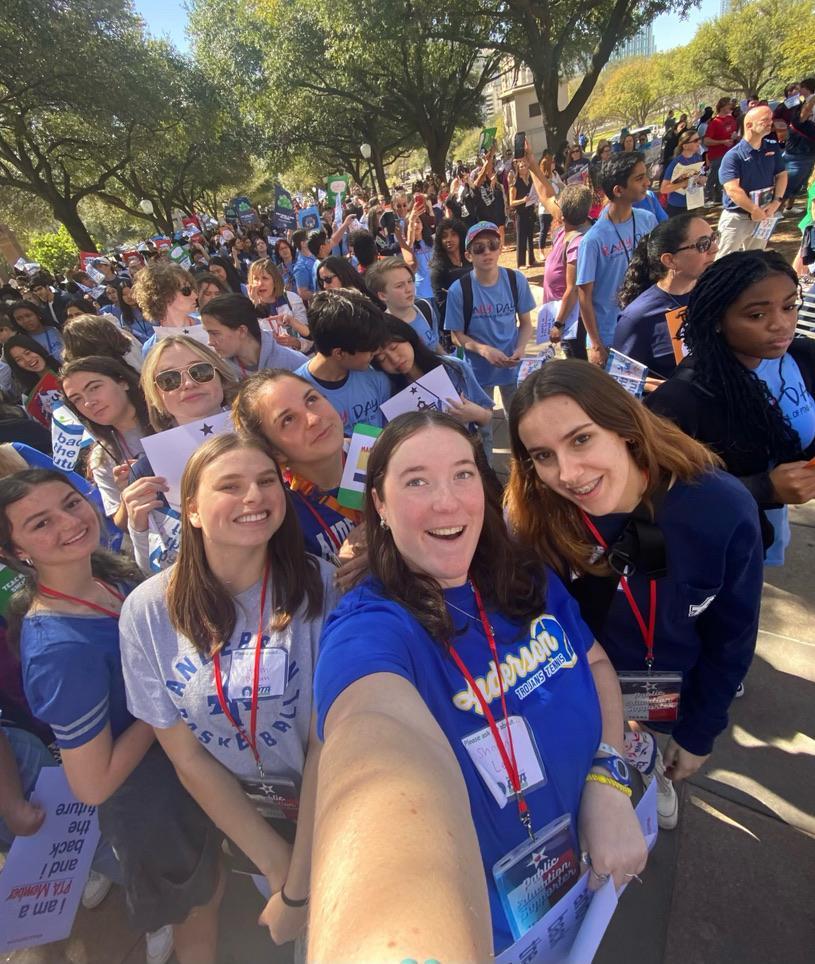Rally Day? More Like Rally-Yay!
By Allie Meachum |StaffWriter
On February 27, as a part of Texas PTA Rally Day, hundreds of students, teachers, and parents flooded the capital to advocate for public education. As the first Rally Day since quarantine, the PTA pushed strong legislative priorities for the 88th session, focusing on increasing the basic allotment (how much money goes to each school district), funding schools based on enrollment insteadofattendance,increasingteacherretention, supporting student’s mental health, getting rid of the A-F accountability system, and opposing vouchers. While Rally Day doesn’t guarantee that the PTA’s agenda will become a reality in the coming session, it allowed for legislators to hear fromstudentsallacrossTexas,includingagroupof studentsfromAndersonHighSchool.

Rally Day began with the allocation of essentialmaterials:aflag,abadge,andanapple,in case you got hungry before lunch. Afterward were thePrioritiesCaucusandtheStudentCaucus,with the parents and some teachers going to the Priorities Caucus, and the students, as one would assume, going to the Student Caucus. The caucus includedStateRepresentativesJamesTallericoand Caroline Harris. When asked, the Anderson
Students found Tallerico extremely interesting and insightful, with one student simply saying, “I enjoyed James Tallerico’s presence.” Tallerico’s position was extremely pro-public education and was unafraid to be open about the need for real change, change that aligned with the PTA’s goals fortherally.RepresentativeHarrisseemedtostray away from discussion on school policy, instead thanking students for showing up, detailing how she herself ended up elected, and encouraging students to continue being active in their government. Afterward, a group of staff members from the capital spoke, with the caucus then concluding with a student panel made up of students with unique leadership positions at their schools.
After the caucuses was the titular rally. Following a performance by a high-school cheer teamandanotherbyanamazingband,whoplayed a mean “Country Roads,” speakers from both the Student and Priorities Caucus spoke once again. However, instead of the respectful, quiet atmosphere of the Student Caucus, the rally was electric.Everypausefromaspeakerwasfilledwith deafening cheers from the audience, as well as impassionedpostershakingandflagwaving.
With the conclusion of the rally, after a short but delicious lunch break (thank you Jason’s Deli) the event shifted from Representatives only talking at you, to a conversation between Representativesandyou,heldinconferencerooms that fit no more than 20-30 people. The group of Anderson students, as well as a group of students from LASA, met with Representatives James Tallerico, Gina Hinojosa, and Donna Howard. The conversations primarily centered around increasing funding for public schools, while keepingsaidfundingfromgoingtowardsvouchers, whichwouldtakemoneyawayfrompublicschools and give it tofamilies topay for private schools
TSJCL Area Tournament
 By Erika Tuttle |StaffWriter
By Erika Tuttle |StaffWriter
instead.Whilethesemeetingswere“veryinsightful and informative,” said one of the Anderson students,therepresentativestheyspoketowereall very supportive of public education. This resulted in many feeling as if they hadn’t made a huge difference, and were instead just reinforcing pre-existing beliefs instead of enacting change. However, the representatives assured the students that by showing up they were already making a difference, and by continuing to be vocal and exercising their vote once old enough, they would continue to impact the legislation that governs them.
While not an official part of Rally Day, Anderson students were taken on a special tour of the capital, given by a lobbyist that works in the capital and happens to be the parent of two of the attending students. Students got to see the House and Senate chambers, as well as go into the offices of some representatives and meet with them personally.Thetourguidegavegreaterinsightinto thelogisticsofactuallypassinglegislationandhow what we were advocating for during Rally Day wouldmanifestitselfduringthesession.
Overall, Rally Day was an extremely informative and satisfying experience for the studentsthatattended.ShaynaLevi,VicePresident ofthePoliticalScienceClub,describeditas,“really cool to get to hear firsthand from politicians who support public education.” Not only was the experiencealearningopportunity,butitallowedus toshowupandfightforacausethatwebelievein. Advocatingandshowingupforwhatyoubelieveis one of the most effective ways to inspire change, and Rally Day allowed the students of Anderson High School to do just that. Thank you to the members of the Texas PTA that organized the event, and the amazing Anderson chaperones that oversawthetrip,withoutwhomnoneofthiswould havebeenpossible.
The Latin Club had been preparing for the Area Event for months, with about 30 students competing this year. The TSJCL Latin Area Event was held at Murchison Middle School on February 25th, where students of all levels competed within their chosen categories. Latin students from multiple schools all over Austin were also competing, to earn points for their schools to help their chances at State. So, congratulations to all of the students who participated, and helped earn pointsforourschoolthisyear!
Everyone who attended had the option to participate in specific academic competitions, along with assorted other events that were being hosted. Based on the level that was scored by each participant, the school would be awarded a certain amount of points. So, the students listed below scored high enough to be eligible to add a certain amountofpointstoouroverallscore.
The Latin Club had been preparing for the Area Event for months, with about 30 students competing this year. The TSJCL Latin Area Event was held at Murchison Middle School on February 25th, where students of all levels competed within their chosen categories. Latin students from multiple schools all over Austin were also competing, to earn points for their schools to help their chances at State. So, congratulations to all of the students who participated, and helped earn pointsforourschoolthisyear!
Everyone who attended had the option to participate in specific academic competitions, along with assorted other events that were being hosted. Based on the level that was scored by each participant, the school would be awarded a certain amount of points. So, the students listed below scored high enough to be eligible to add a certain amountofpointstoouroverallscore.
Hydrothermal Vents: The Ecosystem You’ve Likely Never Seen
Sunlight is the foundation of many ecosystems. From plants to alpha predators, an uncountable number of creatures rely on it in some way or another to survive, including humans. Without sunlight, millions of species would simply not be able to exist. However, 2,000 meters below thesurfaceoftheocean,experiencingpressures200 times greater than that of the surface, where not even a sliver of sunlight can reach, life manages to flourish in magnificent quantities. How could this be? At 2,000 meters down, the pressure is roughly equivalent to 5 jet engines stacked on top of each other. Additionally, in perfect conditions, sunlight can reach depths of 1,000 meters before becoming insignificant but normally fades out at 200 meters below sea level. At 2,000 meters down, it is simply impossible for any photosynthetic processes to occur.Lifeasweknowitsimplycouldnotexistdown here. That’s the thing, though. Life down here is alien.
Everything about these ecosystems, from their producers to their predators, is astronomically different from those on the surface. For starters, these ecosystems are metaphorically and physically built around geological formations known as hydrothermal vents. Hydrothermal vents are, put very simply, cracks on the seafloor that gush out mineral-rich water at temperatures up to 470 degrees Celsius. Despite these temperatures, the water remains liquid due to the intense pressure preventing the water from evaporating. This mineral-rich water, carrying many nutrients necessary for life, is precisely what allows life to flourisharoundthesevents.
Gettingthenutrientsfromthis‘soup’isquite complex.Ratherthanconsumethesoupthemselves, creatures either feed on or form symbiotic relationships with chemoautotrophic bacteria, the
Brandon Choyce | Staff WriterPompeii worms, a type of polychaete worm named after its extreme resistance to heat, feed directly on thebacteriaastheirfoodsource.
These chemoautotrophic bacteria are probably the only constant across all hydrothermal vents.Noindividualventisthesame,andthefactors affecting the vent tend to decide what creatures live aroundit.Onemajordifferencebetweenventsiswhat color of smoke they release, either black or white. ‘White smokers’ are basically the calmer cousin of ‘blacksmokers’,releasingadifferentmineralmixata muchlowertemperature,resultinginadifferentarray ofcreaturesaroundwhitesmokevents.Theregionof the vent also seems to affect biodiversity, with Atlantic vents noticeably missing the giant tube worms of the Pacific vents. Over 300 new species have been discovered near hydrothermal vents that don’tliveelsewhere.
Regardlessoflocation,lifearoundtheventsis notonlybeautifullyunique,butalsodifficulttostudy. Duetotheextremepressureswheretheseventsexist, thecreatureswoulddieimmediatelyifbroughttothe surface, making it nearly impossible to study these creatures in a lab. This extreme pressure is exactly what causes many creatures to look much different than those on the surface, even looking somewhat alien.
The most alien of all, however, has to be the Relicanthus Daphneae, a creature vaguely related to jellyfish and sea anemones (Pictured, above). We know so little about this creature that there is a dispute about what it should be classified as. First discovered sometime in the 1970s, scientists in 2006 classified it as a very large sea anemone that only livedintheareasnearbyhydrothermalvents.Genetic testingofthecreaturerevealedthatitwas,infact,not an anemone, but rather something from an entirely new order of creatures. Other than that, not much
Is TV really worth it?
 Beatrice Hull | Staff Writer
Beatrice Hull | Staff Writer
Screen time has become an increasingly common part of modernchildhood,withchildrenspendingmoreandmoretimein front of screens such as computers, tablets, and smartphones. Therearegrowingconcernsaboutthenegativeeffectsofexcessive screentime.Oneofthemostsignificantconcernsistheimpacton children'sphysicalhealth.Spendinglonghourssittinginfrontofa screencanleadtoasedentarylifestyle,whichcanincreasetherisk of health issues. Children who spend more time on screens may alsoexperienceeyestrain,headaches,andneckandshoulderpain. Another concern is the impact on a child's social and emotional development. Excessive screen time can limit opportunities for children to engage in face-to-face interactions and develop social skills. It also leads to a decrease in the amount of time spent on activities such as outdoor play, which can be important for a child's emotional well-being and development. Also, research suggeststhatexcessivescreentimecanhaveanegativeimpacton achild'scognitivedevelopment.Childrenwhospendmoretimeon screens may have difficulty with attention and focus. There are also concerns about the impact of screen time on sleep, some studies suggest that it can interfere with the quality and quantity of sleep that children get. Overall, the side effects of excessive screentimeseemlargecomparedtothebenefits.
livingnearventshavesomeuniqueandinteresting aspectaboutthemthatenablesthemtoliveinthese otherworldly environments. New creatures continuetobediscoverednearthesevents,suchas the Pyrolycus jaco fish discovered at a vent site nearCostaRicainJanuaryofthisyear.
Hydrothermal vents are possibly the very place where life on Earth started, thousands of meters below the surface. They provide the perfect environmentformicrobiallifetoevolvewithoutthe need for sunlight. Recently, there have been hydrothermal vents detected on planets such as Enceladus, a moon of Saturn that has a sea of saltwater below its surface. Maybe, a couple of decades in the future, we may find life on other planetsaroundventsjustlikethese.
Anunknownspecimenof Relicanthus Daphneae, aformofswimminganemoneonlyfoundnear hydrothermalvents.

Credit:Whoi.edu
Will We Finally Have Our First Female President?
Kelsey Lind | Secretary
Ahotnewpresidentialcandidate has entered the building. . . and it’s not Ron DeSantis. In fact, it’s not even a man. It’s a woman, and her name is NikkiHaley.
Haley is the former governor of South Carolina, and is one of the three Republican presidential candidates that has announced their bid for the White House. Although she served under Trump as Ambassador to the United Nations between 2017-2018, she was reluctanttovoteforhiminthefirstplace – endorsing Marco Rubio and Ted Cruz beforevotingforhim.
Now, Haley is making strides as a woman in the Republican bid for president who is the daughter of Indian immigrants, and is substantially younger than party favorites on either side of the political spectrum. She’s never lost an election, and has been prominent in SouthCarolinapoliticssince2005.
SherecentlyappearedinIowato rally voters there and discuss lowering the retirement age for younger generations in the workforce. With her experience as UN Ambassador, it is expected that much of her campaign will revolve around foreign policy and her distaste with the way that both Democrats and Republicans have been increasinggovernmentspending.
Haley is set to make history whichever way the election goes, but the question remains as to what type of historyshewillwrite.
Teacher Feature! Learn more about our Anderson Educators
Abby Marloh|SchoolFunctionsChairFast Facts
Fast Facts
●Playedicehockeyandtennis
● Wanted to be a sports media broadcaster
● Describes herself as “basic” inhighschool
Elwell(left)inherfreshmanyear,2014.Ms.Asadourian(left)inhigh school. Sydney Elwell (they/she) currently teaches Pre-AP Biology, Pathophysiology, and Medical Microbiology. This is her first year at Anderson. She said, “High school was fine. I didn't love it at the time, and I wouldn'ttakeatimemachinetogoback.Itisfunnynow tolookbackonthough.”

Ms. Asadourian (left) in high school. Nanor Asadourian (she/her) teaches Principles of Engineering and Fundamentals of Computer Science. She said her high school experience was special because she went to a school focused on science and technology, but she said, “still very typical, filled with teenage angst and relationship drama.”
Nanor Asadourian
● Said she was, “...quiet in my classes. I skipped a lot. (Don't tell my mom!) It was the 90s. I wore a lot of flannel in 95-degree heat. Braces.TheRachelhaircut.It wasavibe.”






